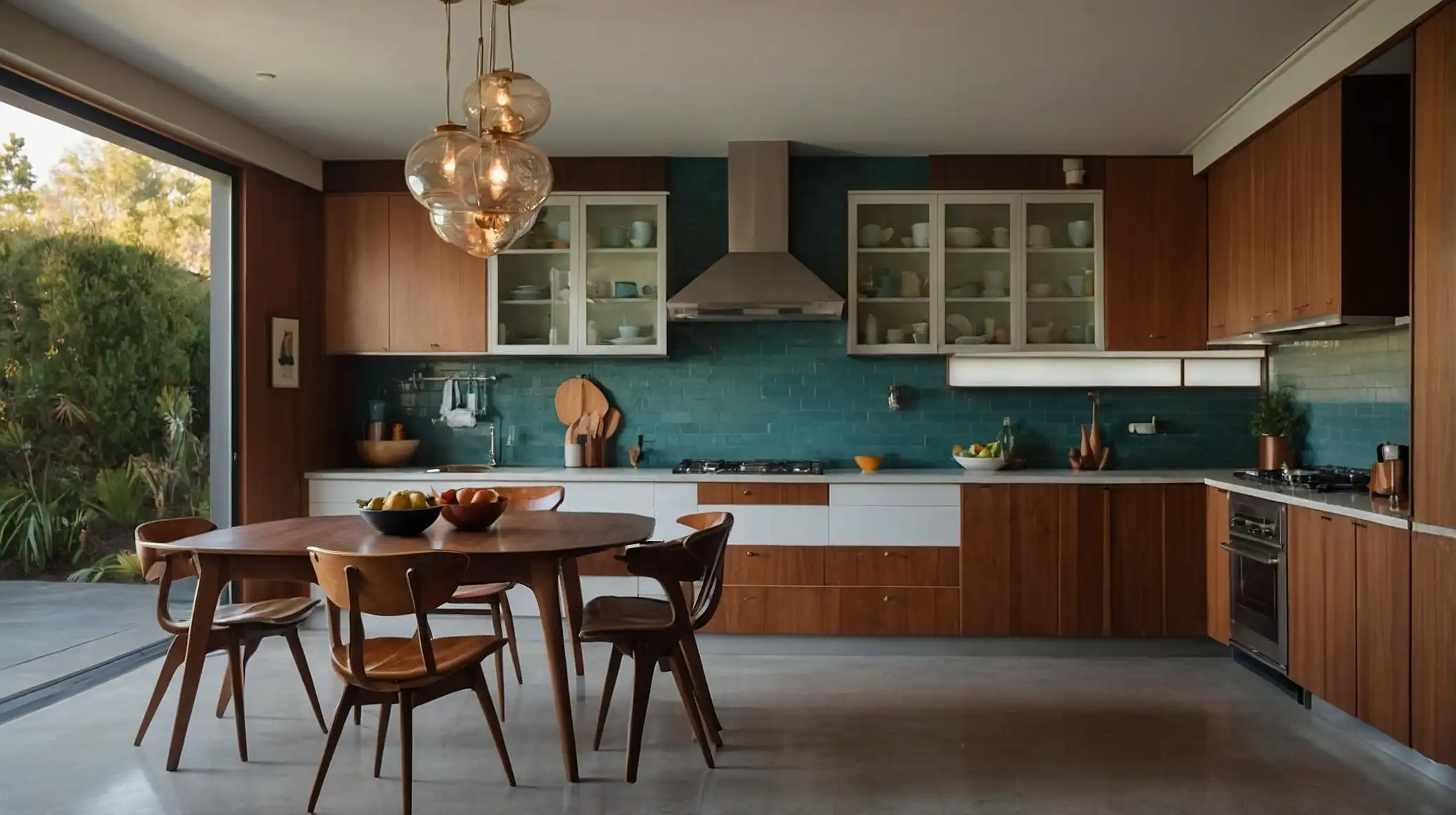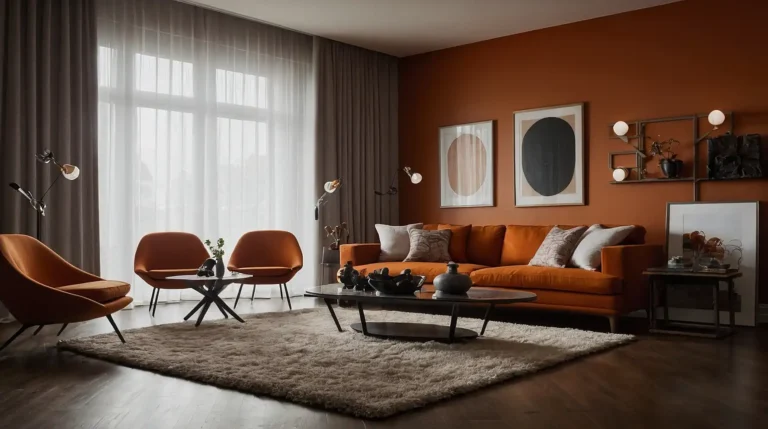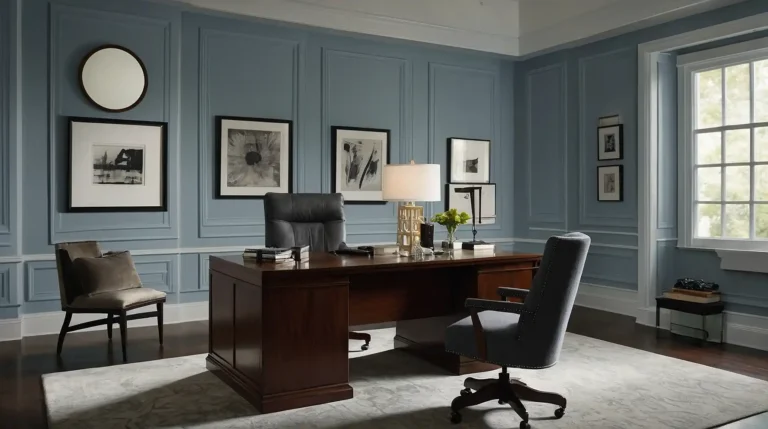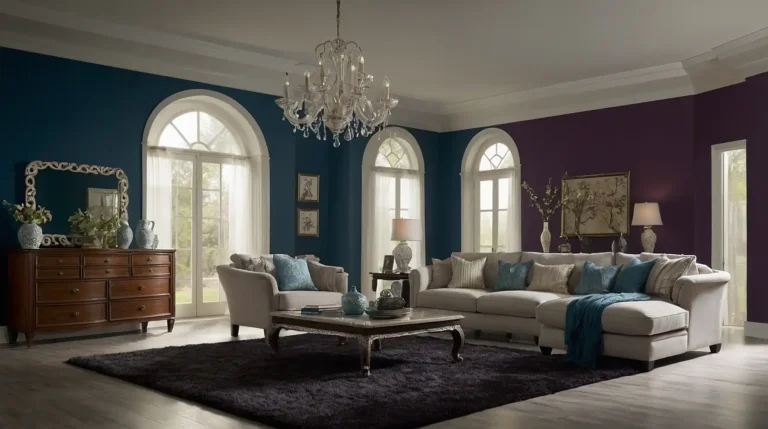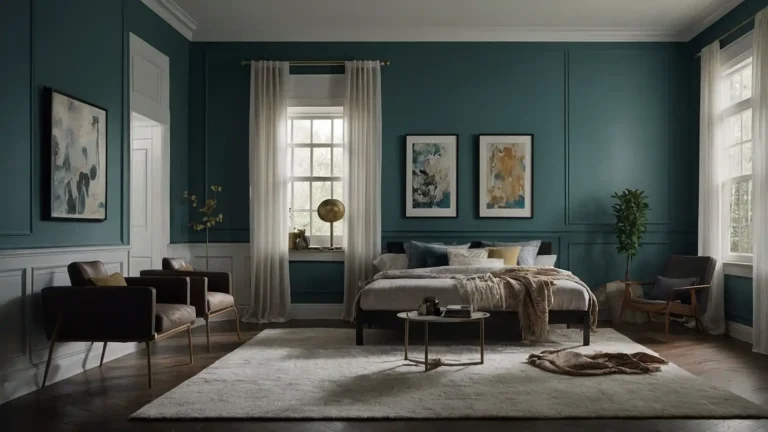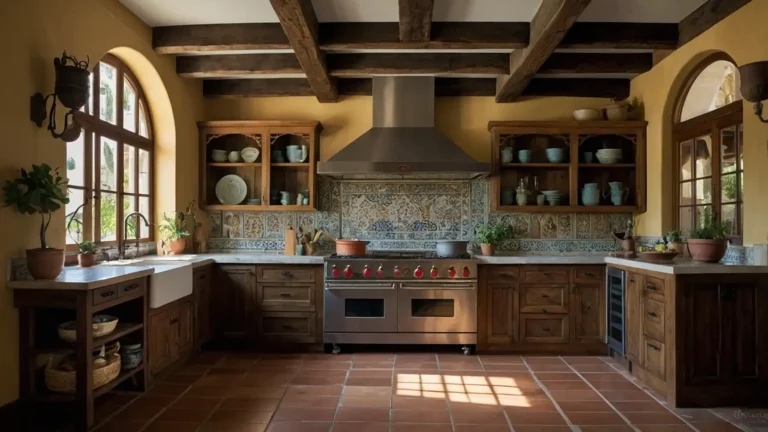27 Mid Century Modern Kitchen Designs and Tips
Mid-century modern kitchens blend clean lines with warm, natural materials beautifully.
You’ll create spaces that feel both retro and timelessly contemporary.
This iconic style emphasizes function and simplicity. Open layouts and sleek finishes define the aesthetic.
These 27 designs and tips help you achieve authentic mid-century kitchen perfection.
1: Flat-Panel Cabinet Doors
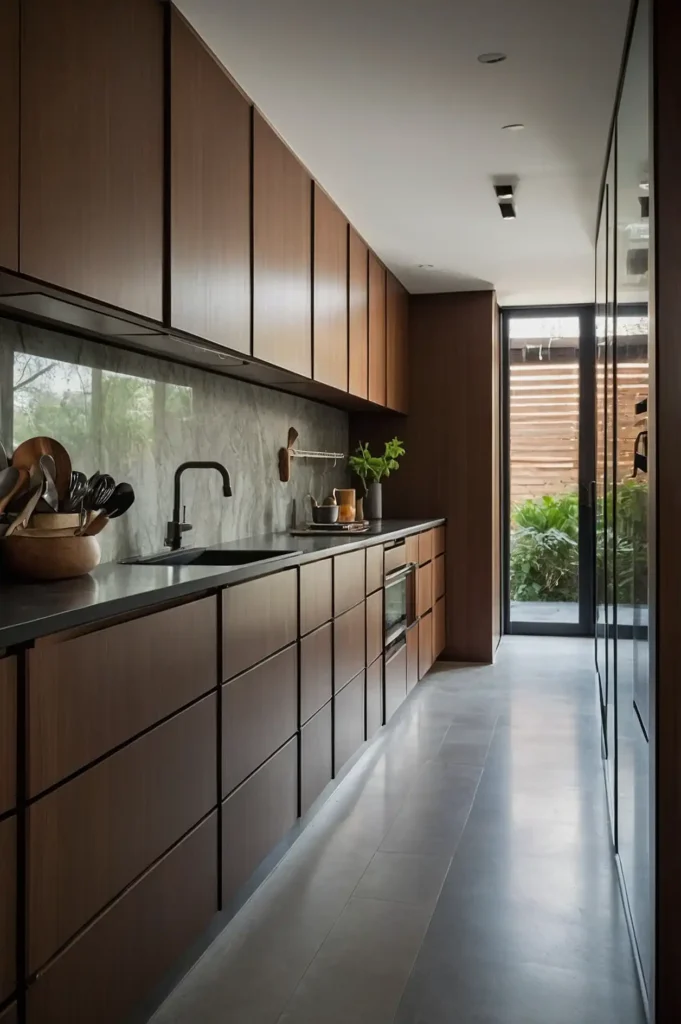
Choose flat-panel cabinet doors without decorative molding for authentic mid-century appeal.
This streamlined approach emphasizes clean geometry and uncluttered surfaces.
Your kitchen gains the signature minimalist look that defines the era.
The simple panels showcase beautiful wood grains without distracting details.
Select quality wood species like walnut, teak, or oak for period-appropriate warmth.
2: Two-Tone Cabinet Color Scheme
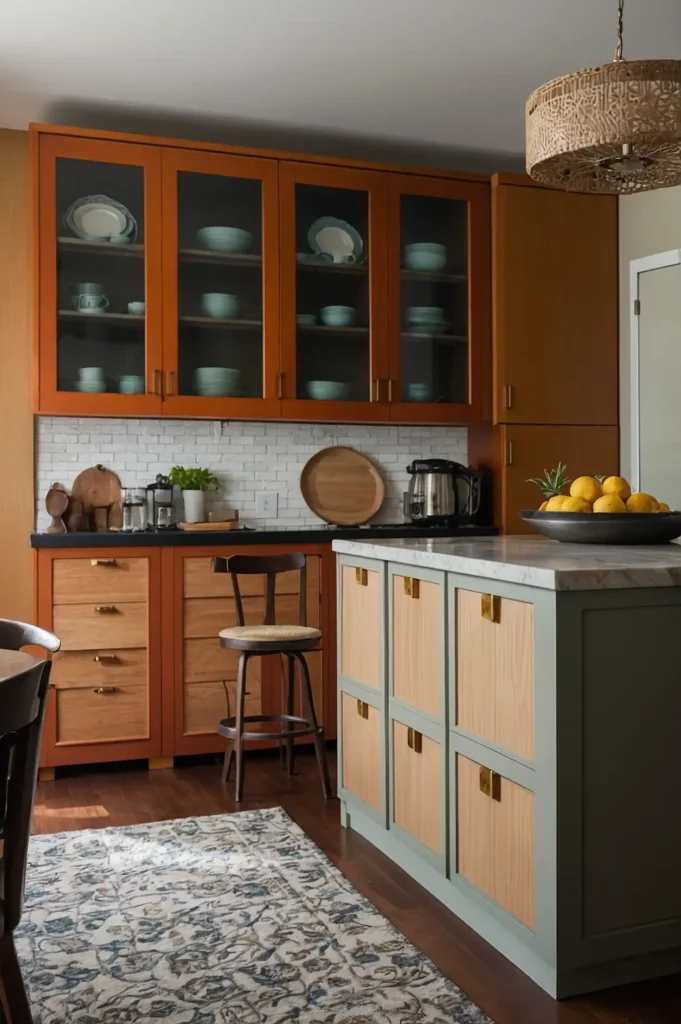
Create visual interest with upper and lower cabinets in contrasting colors.
This classic mid-century technique adds depth while maintaining clean lines.
Your kitchen achieves sophisticated balance with light uppers and dark lowers.
The color contrast prevents monotony while staying true to period aesthetics.
Popular combinations include white uppers with walnut lowers or cream with charcoal gray.
3: Horizontal Wood Grain Emphasis
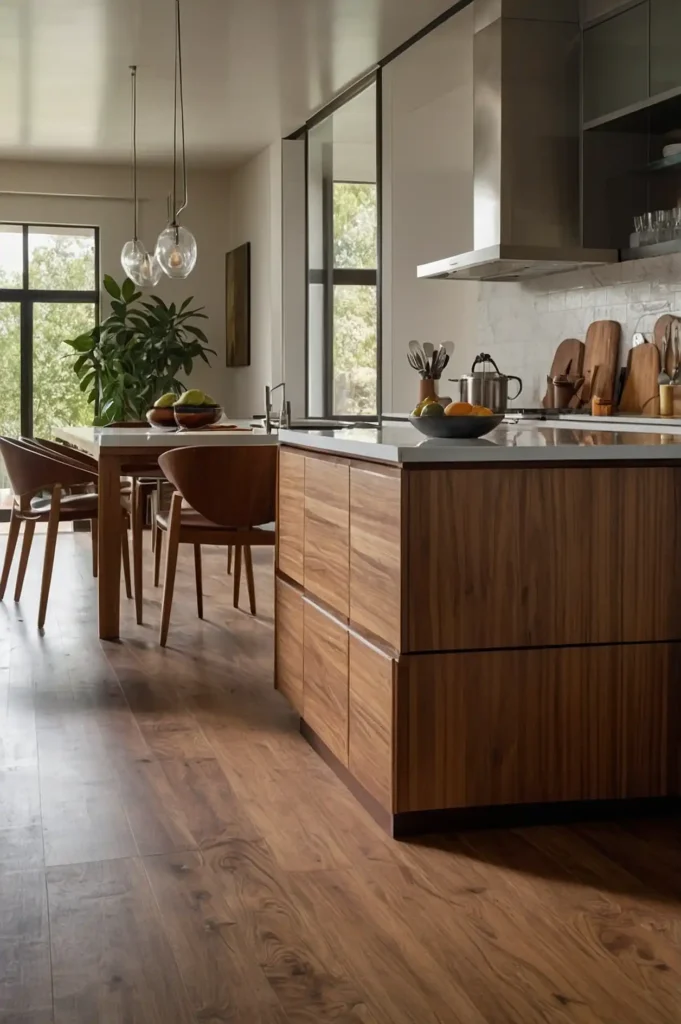
Install cabinets and paneling that showcase horizontal wood grain patterns. This technique creates visual width and emphasizes the era’s love of natural materials.
Your space feels larger with horizontal lines that draw eyes across the room. The continuous grain patterns create cohesive flow throughout the kitchen.
Choose book-matched veneers for dramatic grain continuity across cabinet faces.
4: Sleek Bar-Style Hardware
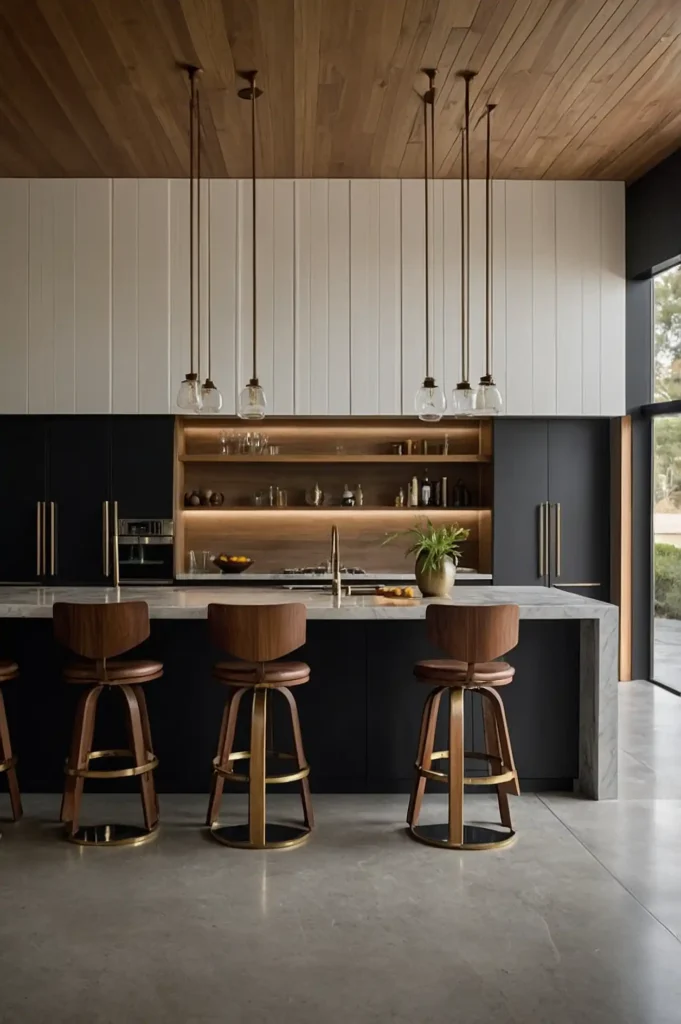
Select long, horizontal cabinet pulls in brass, chrome, or matte black finishes.
This streamlined hardware complements flat-panel doors while adding functional elegance.
Your cabinets gain sophisticated details that enhance the minimalist aesthetic. The horizontal lines reinforce the era’s emphasis on clean geometry.
Avoid ornate or traditional hardware that conflicts with mid-century principles.
5: Geometric Backsplash Patterns
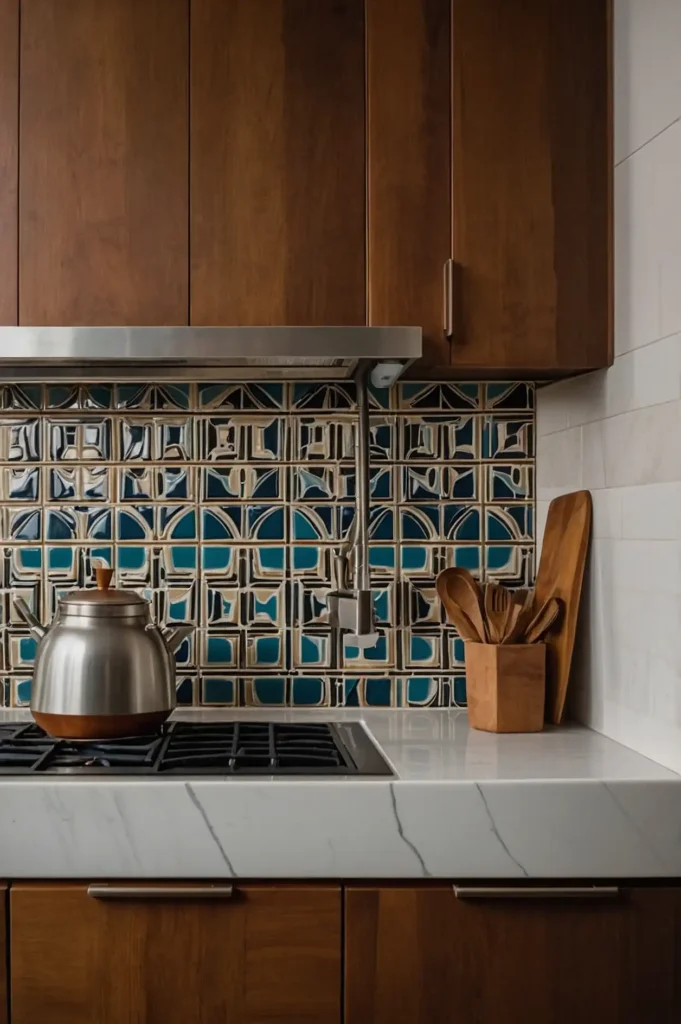
Install backsplashes featuring geometric patterns like hexagons, diamonds, or linear arrangements.
These bold designs create focal points while maintaining period authenticity.
Your kitchen gains visual interest through mathematical precision and artistic flair.
The patterns work as functional art that protects walls beautifully.
Choose colors that complement your overall palette while making statement impact.
6: Natural Stone Countertops
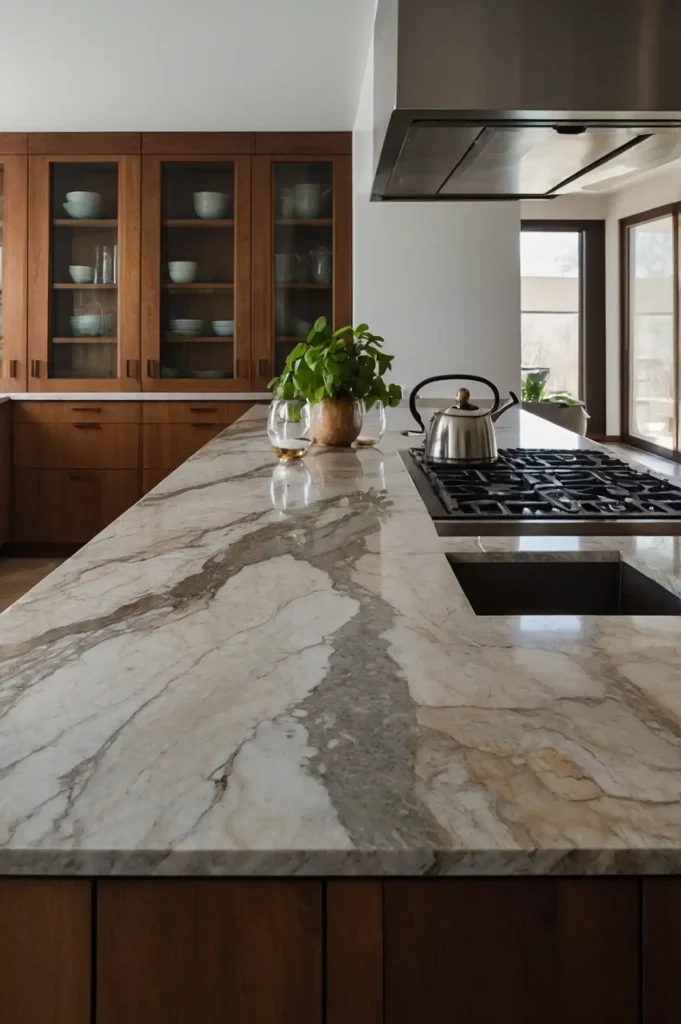
Select natural stone countertops like granite, marble, or quartzite for authentic luxury.
Mid-century kitchens celebrated natural materials in their unprocessed beauty.
Your workspace gains durability with surfaces that age gracefully over decades.
The natural patterns provide organic contrast to geometric cabinet lines.
Choose stones with dramatic veining or consistent patterns depending on your aesthetic preference.
7: Integrated Appliance Design
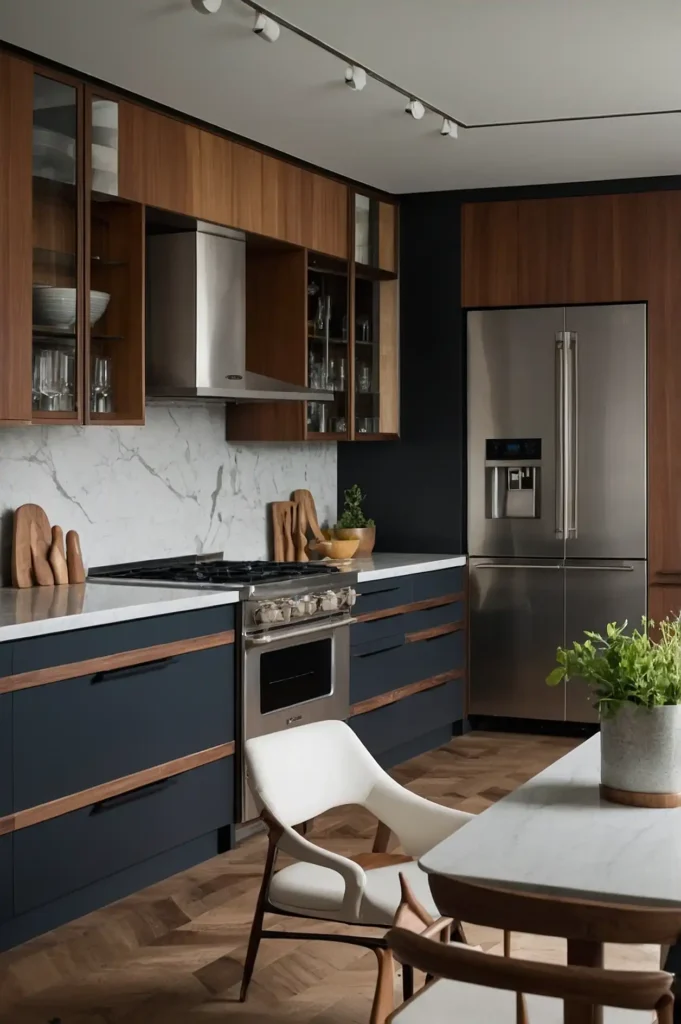
Plan for built-in appliances that blend seamlessly with cabinetry for streamlined appearance.
This approach eliminates visual clutter while maximizing functionality.
Your kitchen achieves the clean integration that defines mid-century modern design.
Hidden appliances maintain uninterrupted lines and surfaces throughout the space.
Include panel-ready options for dishwashers and refrigerators when budget allows.
8: Statement Pendant Lighting
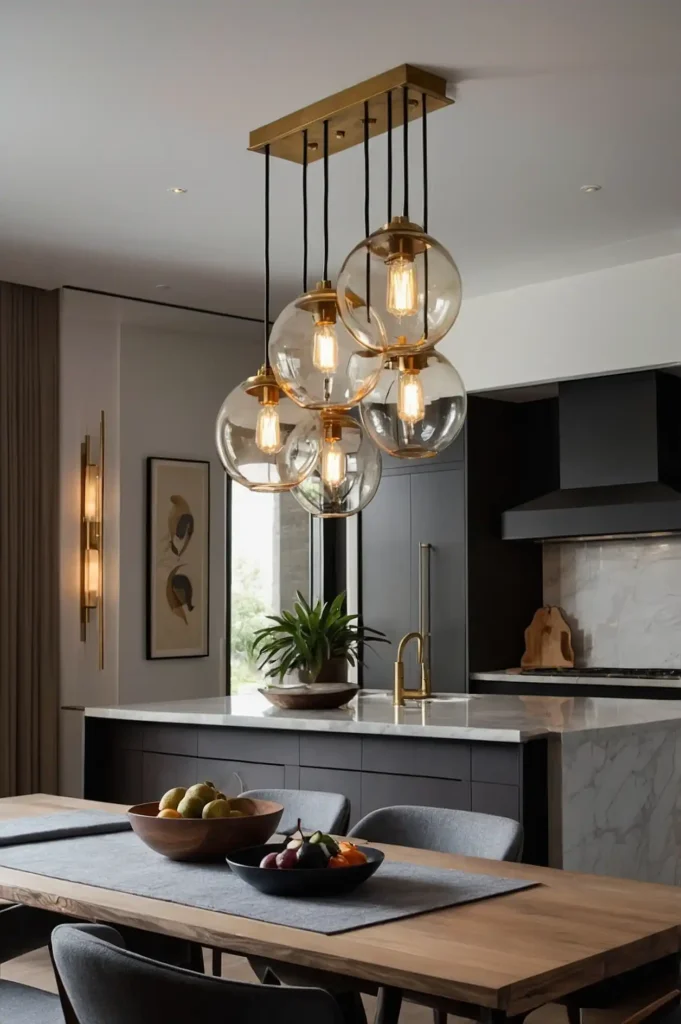
Install iconic pendant lights like Sputnik fixtures or geometric glass shades. These sculptural pieces serve as functional art while providing task lighting.
Your kitchen gains personality with lighting that defines the mid-century era. The fixtures become conversation pieces that enhance overall design impact.
Choose fixtures scaled appropriately for your island or dining area dimensions.
9: Open Shelving Display
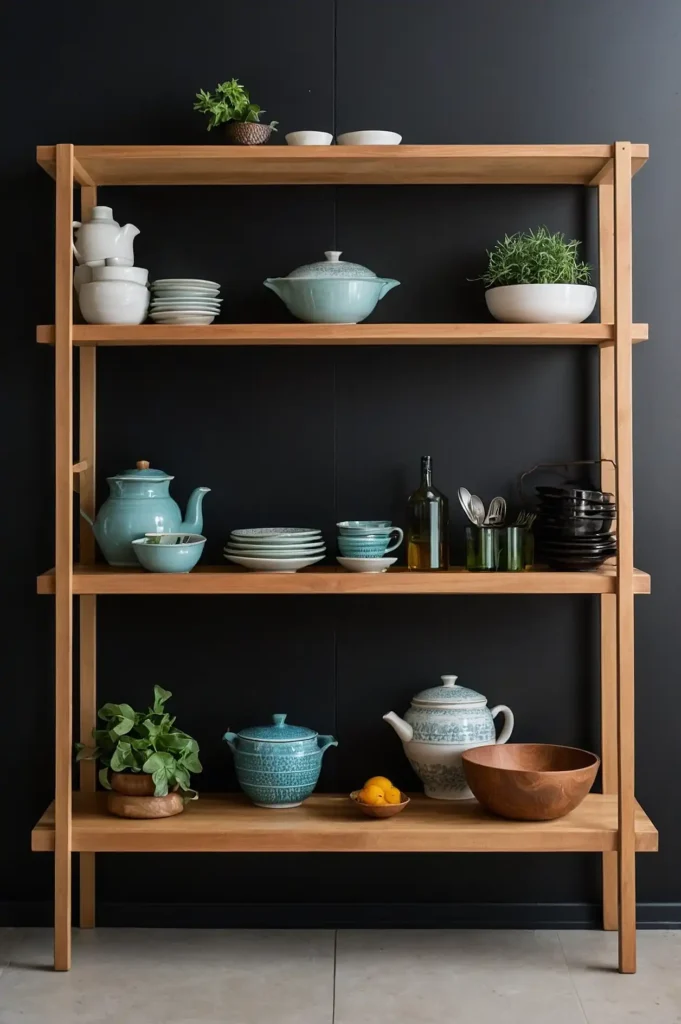
Incorporate open shelving for displaying beautiful dishes and functional objects.
This approach showcases collections while maintaining the era’s emphasis on accessibility.
Your kitchen becomes a curated display space for colorful ceramics and glassware.
The open storage creates visual lightness compared to solid cabinet walls.
Arrange items thoughtfully to maintain clean, organized appearances that complement the aesthetic.
10: Breakfast Bar Seating
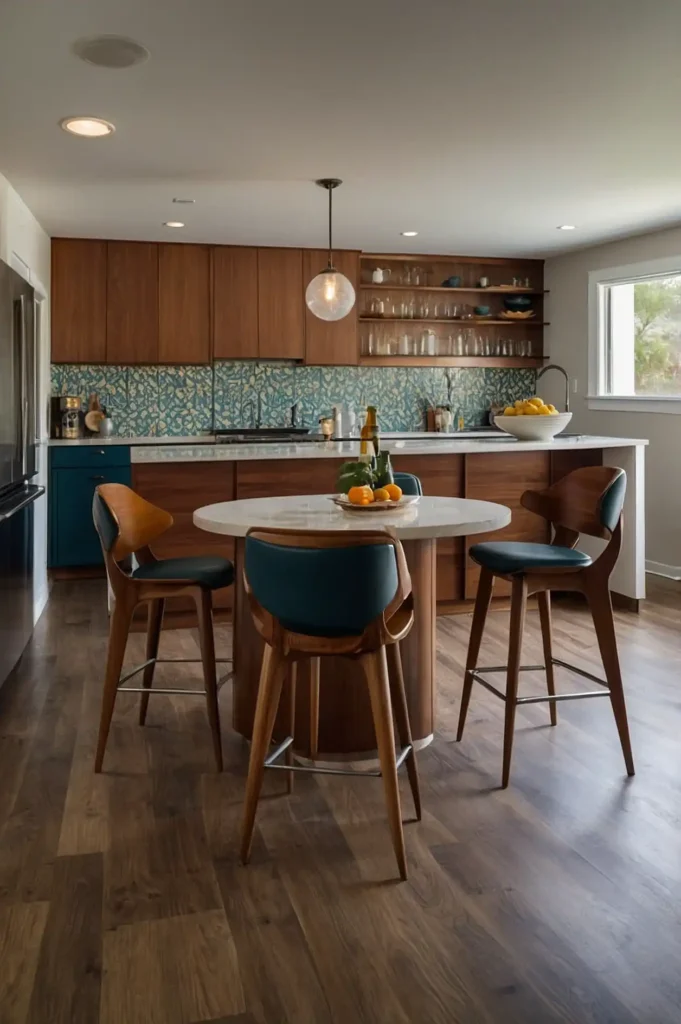
Design a breakfast bar with sleek stools for casual dining integration. This open concept feature connects kitchen and living areas seamlessly.
Your space accommodates both cooking and socializing in true mid-century fashion.
The bar creates informal gathering spots that encourage family interaction.
Choose stools with clean lines and materials that match your overall design palette.
11: Large Picture Windows
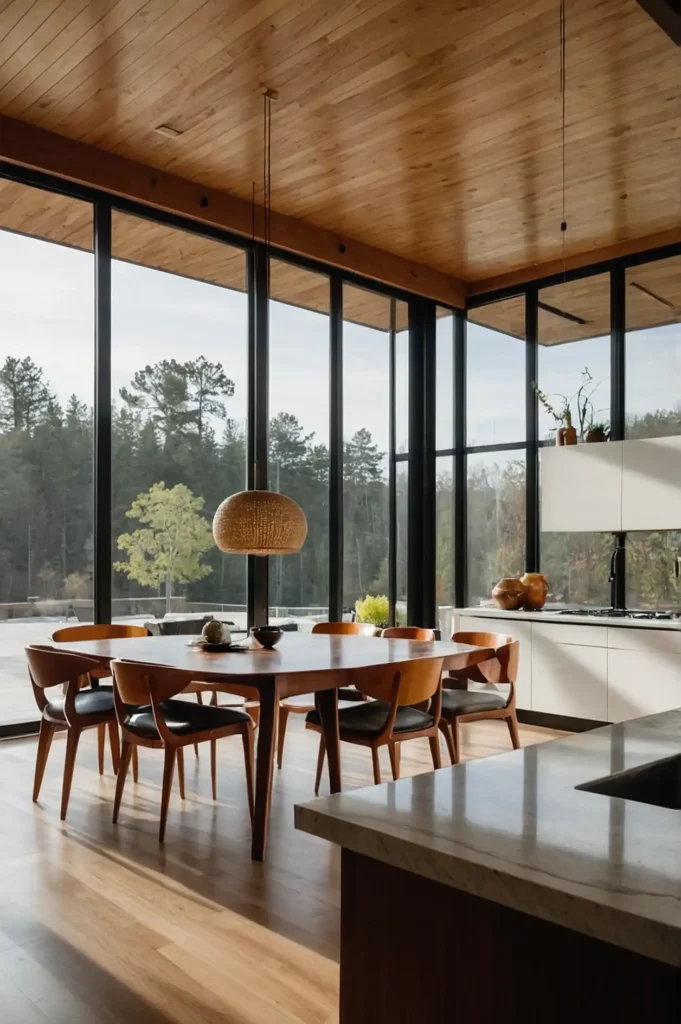
Maximize natural light with expansive windows that connect indoor and outdoor spaces.
Mid-century design celebrated the relationship between interior and landscape.
Your kitchen feels larger and more connected to nature through generous glazing.
The abundant light enhances colors and materials throughout the day.
Consider window placement during renovation to optimize both light and privacy needs.
12: Warm Wood Ceiling Accents
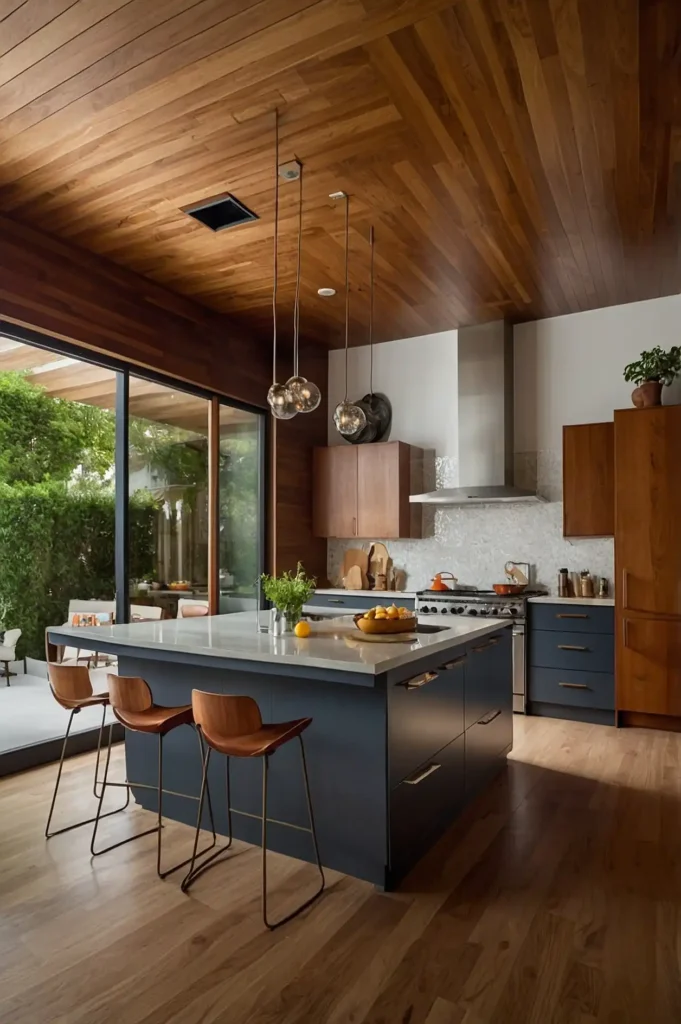
Add warmth with natural wood ceiling planks or beams in contrasting directions.
This technique creates visual interest while maintaining natural material emphasis.
Your kitchen gains architectural character through overhead wood details.
The warm tones balance cool surfaces like stone and stainless steel beautifully.
Choose wood species that complement your cabinet selections for cohesive material flow.
13: Vibrant Accent Colors
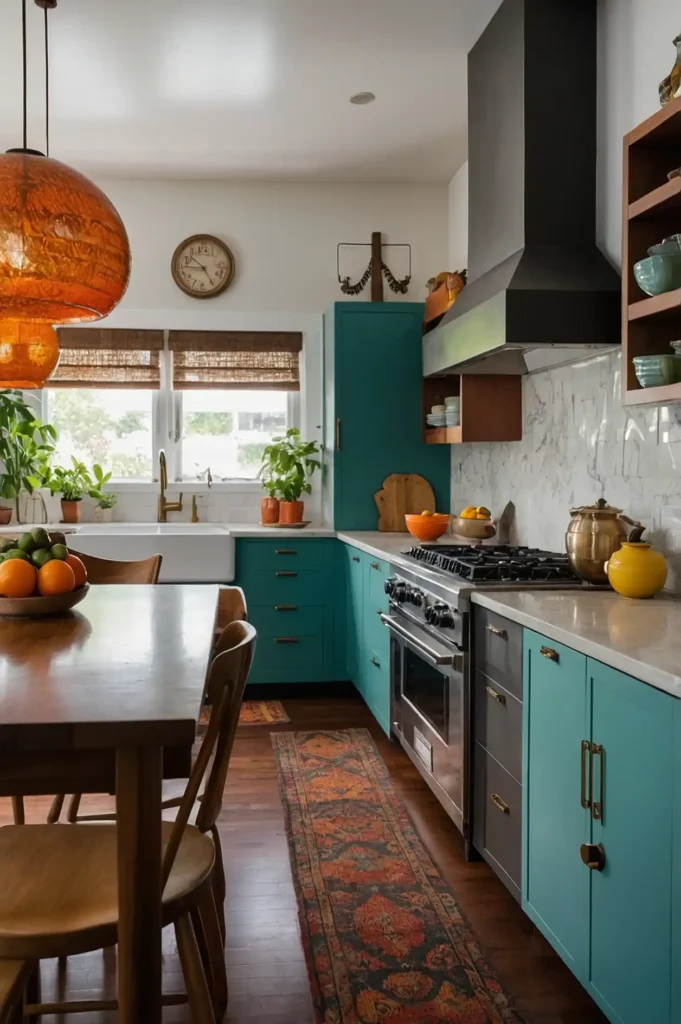
Incorporate period-appropriate accent colors like orange, teal, mustard yellow, or avocado green.
These bold hues capture the era’s optimistic color sensibility.
Your kitchen gains personality through carefully chosen pops of saturated color.
The accents work through accessories, artwork, or single accent walls effectively.
Balance bold colors with neutral backgrounds to prevent overwhelming the space.
14: Terrazzo Flooring Options
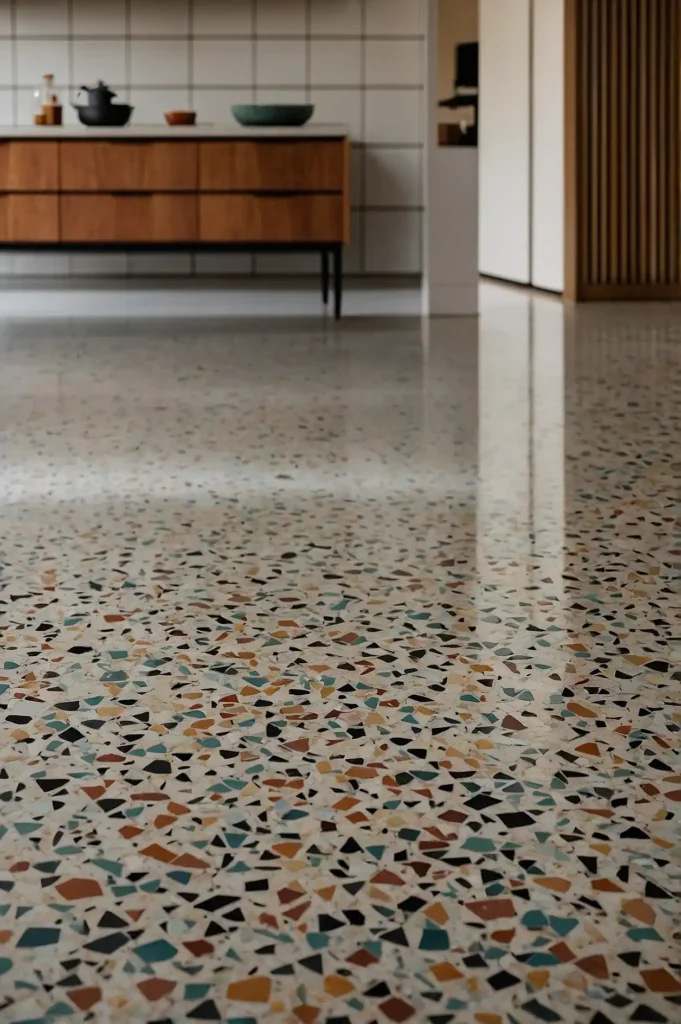
Consider terrazzo flooring for authentic mid-century luxury and durability.
This composite material combines marble chips with cement for unique patterns.
Your kitchen gains a signature flooring material that defines institutional and residential mid-century design.
The speckled patterns hide dirt while providing timeless appeal.
Choose color combinations that complement your overall palette and lighting conditions.
15: Linear Track Lighting
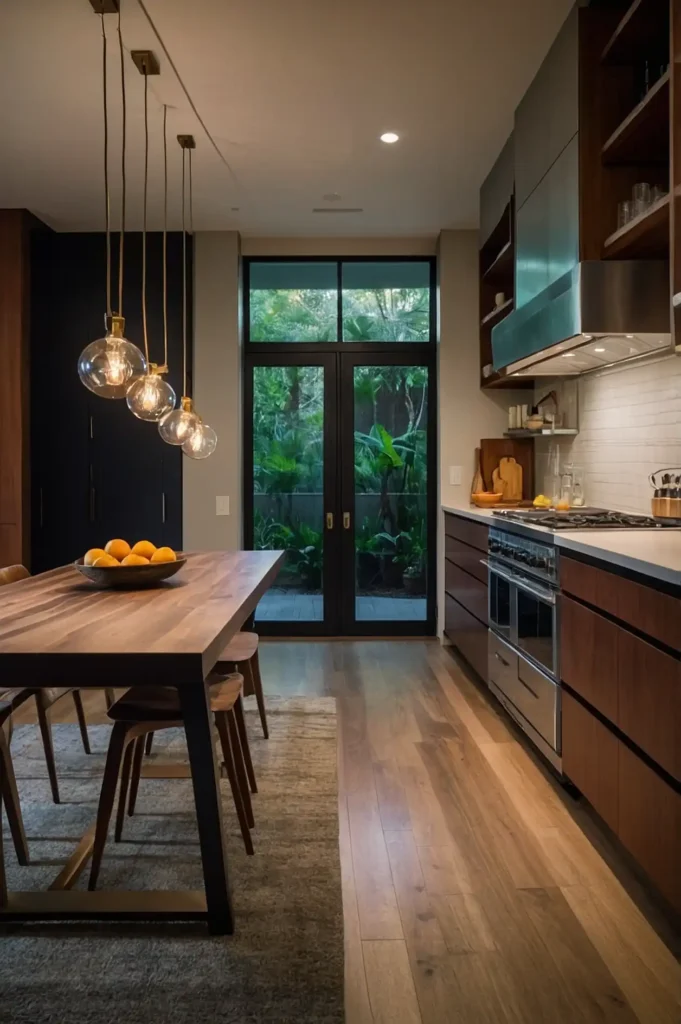
Install track lighting systems that adjust to illuminate different work areas.
This flexible approach provides task lighting while maintaining clean ceiling lines.
Your kitchen accommodates changing lighting needs through adjustable fixtures.
The linear tracks reinforce geometric design principles throughout the space.
Select track systems with period-appropriate fixture heads and finishes.
16: Floating Island Design
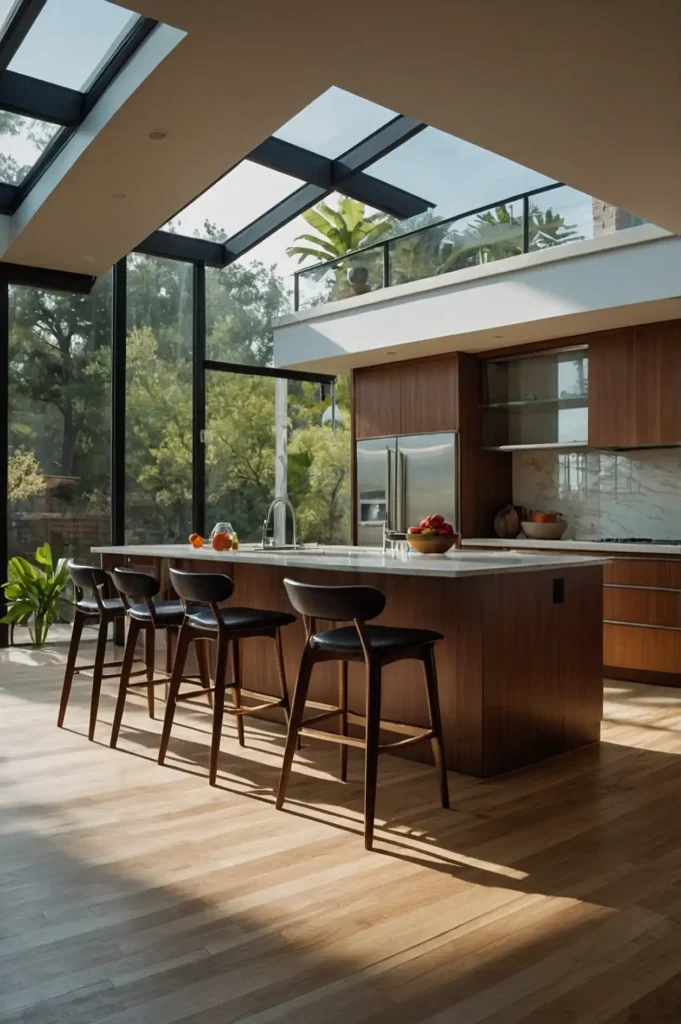
Design kitchen islands that appear to float with hidden support structures.
This technique creates visual lightness while providing essential work and storage space.
Your island becomes a sculptural element that doesn’t overwhelm the room.
The floating effect maintains traffic flow while adding functional surfaces.
Plan structural support carefully to ensure safety and stability for daily use.
17: Glass-Front Display Cabinets
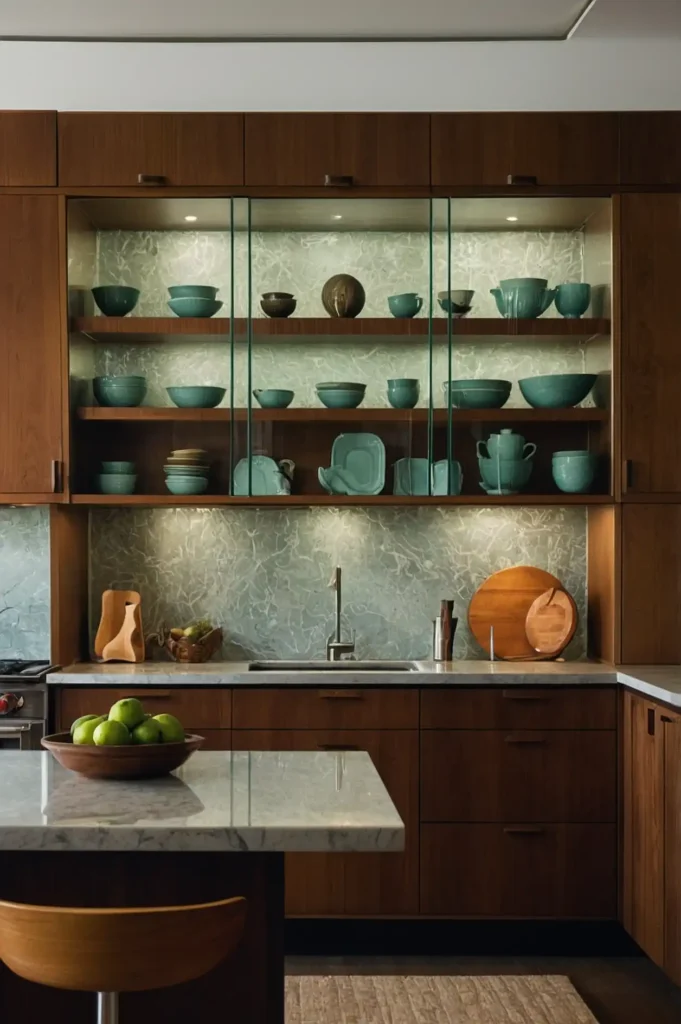
Include glass-front cabinets for displaying beautiful dishes and glassware collections.
This approach adds visual variety while showcasing curated objects.
Your kitchen gains depth through transparent and solid cabinet combinations.
The glass fronts create opportunities for interior lighting and color display.
Choose clear or frosted glass depending on your storage organization preferences.
18: Natural Ventilation Emphasis
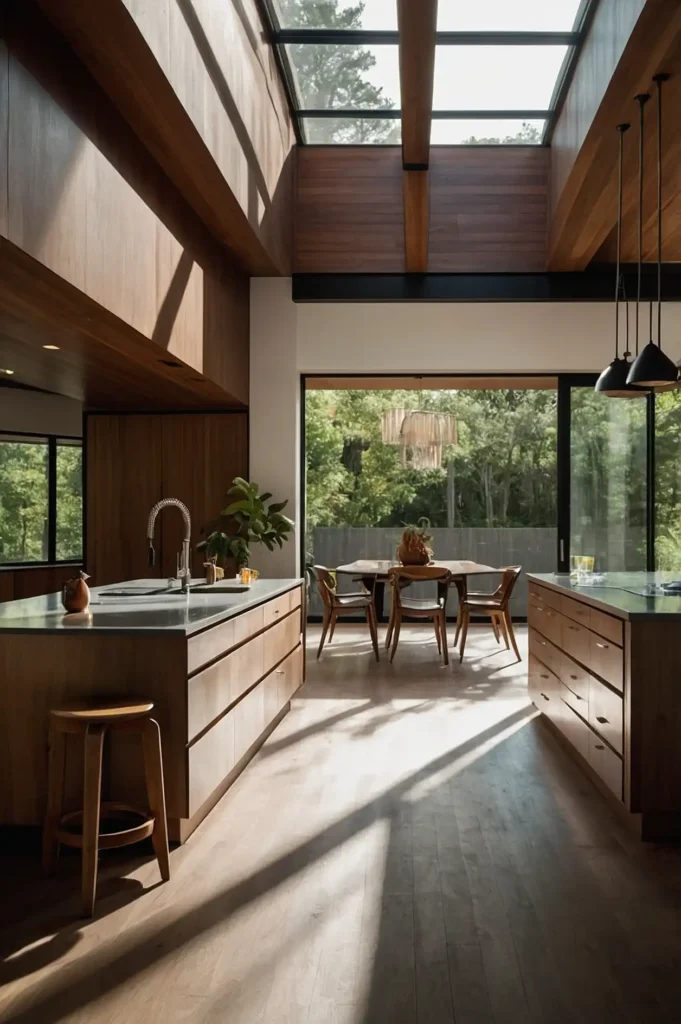
Design for natural ventilation through operable windows and strategic air circulation.
Mid-century homes emphasized connection to outdoor air and breezes.
Your kitchen stays comfortable through passive cooling strategies that reduce energy costs.
The natural airflow prevents cooking odors while maintaining fresh environments.
Plan window placement to create effective cross-ventilation patterns throughout the space.
19: Sunken Conversation Areas
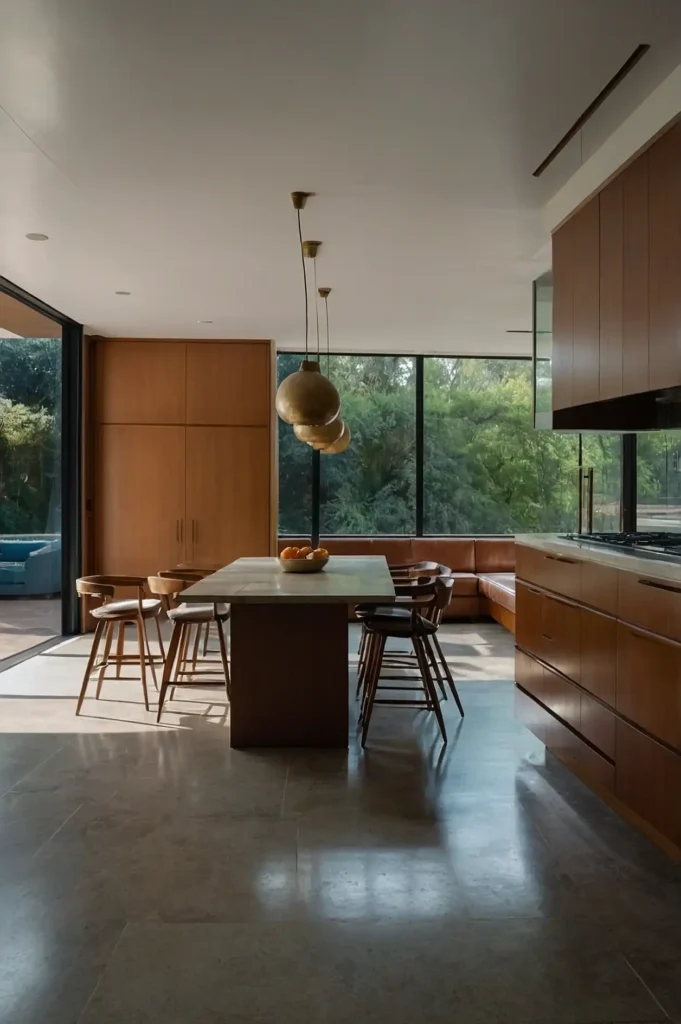
Create subtle level changes that define different functional zones within open floor plans. This architectural technique separates spaces without walls.
Your kitchen connects to living areas while maintaining distinct identity.
The level changes create intimate seating areas within larger open spaces.
Include proper transitions and safety considerations for level changes.
20: Atomic Age Accessories
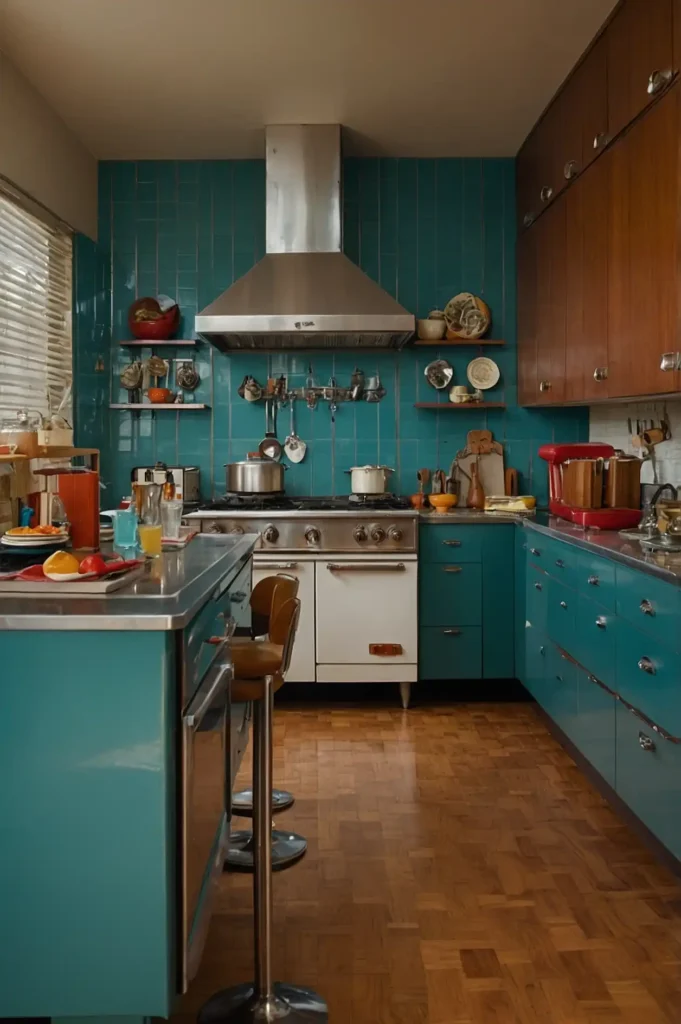
Display period-appropriate accessories like starburst clocks, boomerang ashtrays, or geometric ceramics.
These decorative elements reinforce authentic mid-century atmosphere.
Your kitchen gains personality through carefully curated vintage pieces. The accessories tell stories while enhancing overall design authenticity.
Source original pieces or quality reproductions that capture genuine period spirit.
21: Room Divider Elements
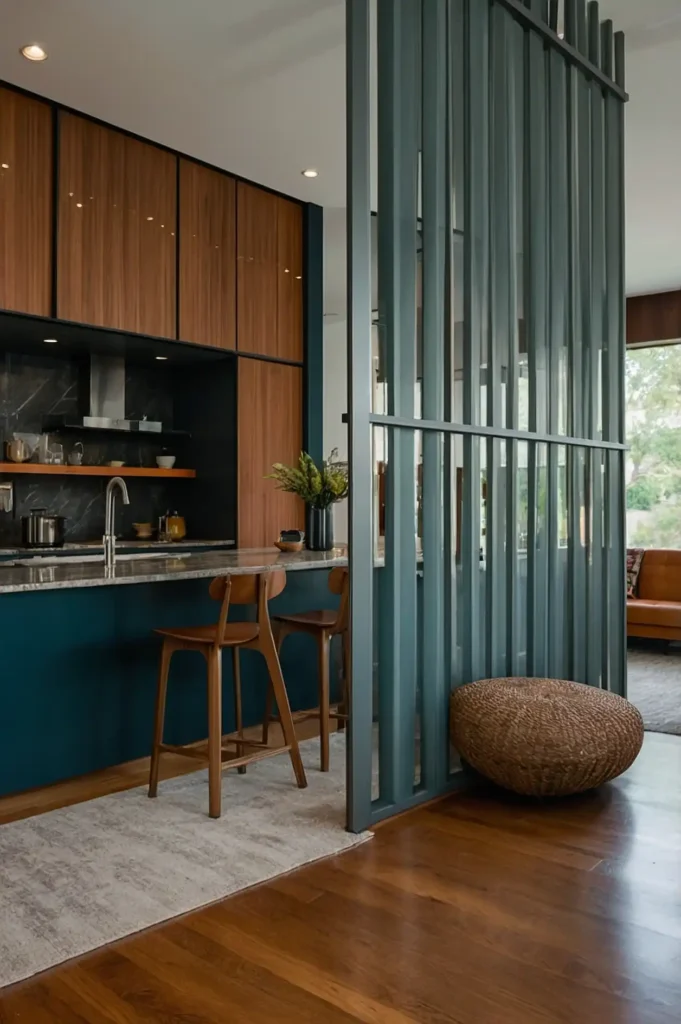
Use partial walls or screens to define kitchen boundaries without complete separation.
This approach maintains openness while creating functional zones.
Your kitchen connects to adjacent spaces while maintaining its own identity.
The dividers provide opportunities for display and storage integration.
Design dividers that serve multiple functions like seating or plant display.
22: Built-In Banquette Seating
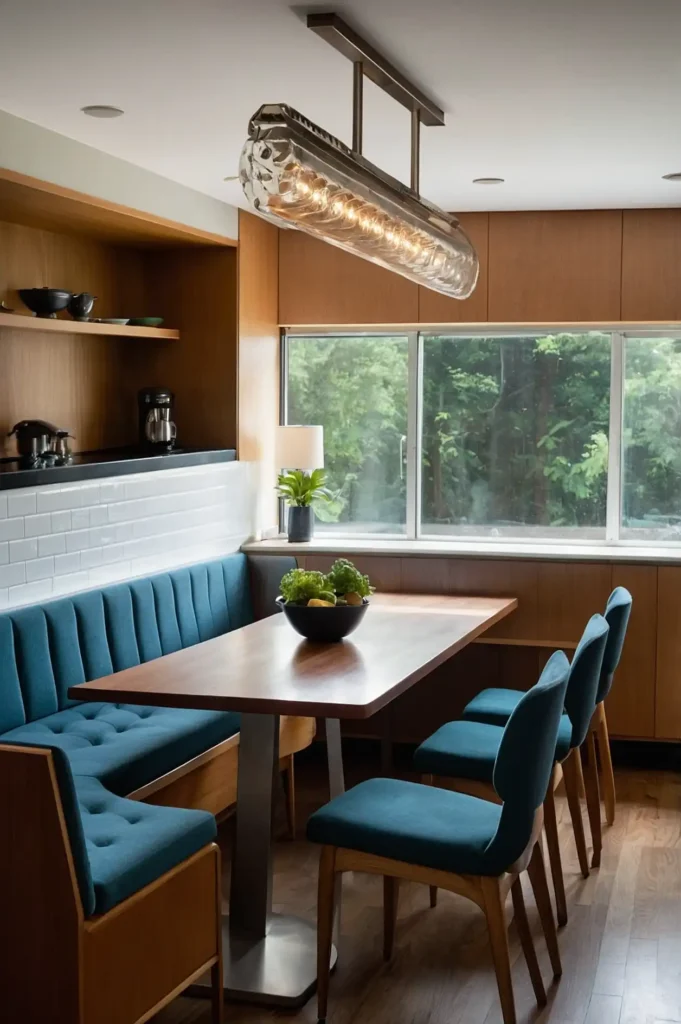
Install custom banquette seating for space-efficient dining solutions. This built-in approach maximizes seating while creating cozy gathering spots.
Your kitchen accommodates more people in less space through efficient design.
The banquettes provide storage underneath while defining dining areas.
Include comfortable cushioning and easy-to-clean upholstery materials.
23: Clerestory Window Lighting
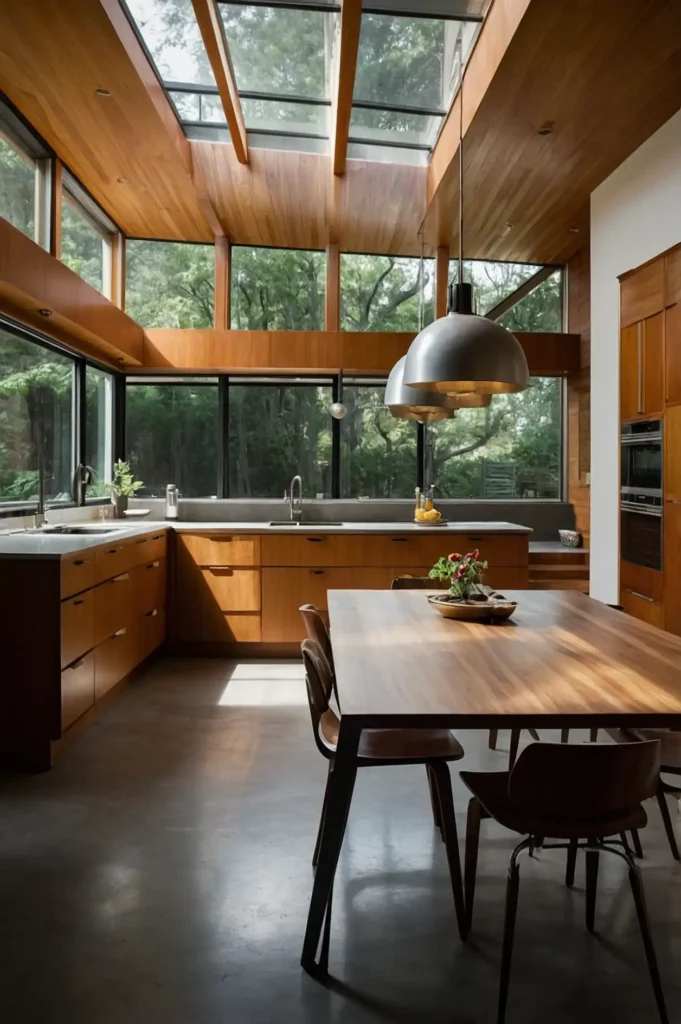
Add high clerestory windows for privacy with abundant natural light. This architectural feature brings light without compromising wall space.
Your kitchen gains illumination while maintaining privacy from neighbors. The high windows create dramatic light patterns throughout the day.
Plan clerestory placement to optimize light while avoiding glare on work surfaces.
24: Sliding Glass Door Integration
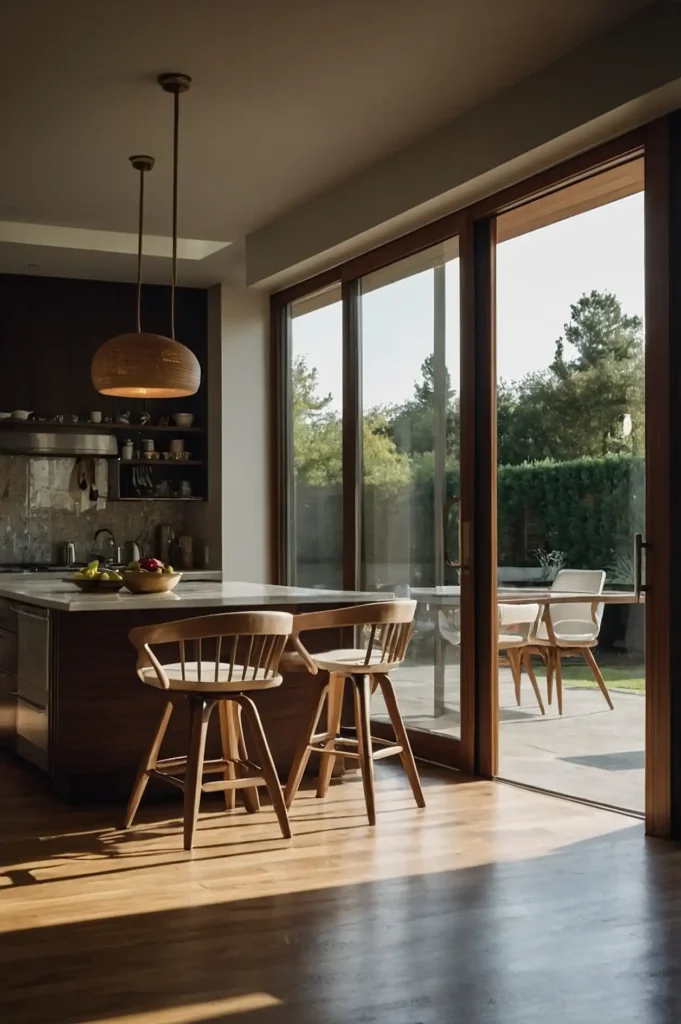
Connect kitchens to outdoor spaces through expansive sliding glass doors. This seamless transition extends living areas into landscape settings.
Your indoor and outdoor cooking areas blend together naturally. The glass doors provide views while accommodating natural ventilation and access.
Choose quality door systems that operate smoothly and provide security.
25: Minimalist Window Treatments
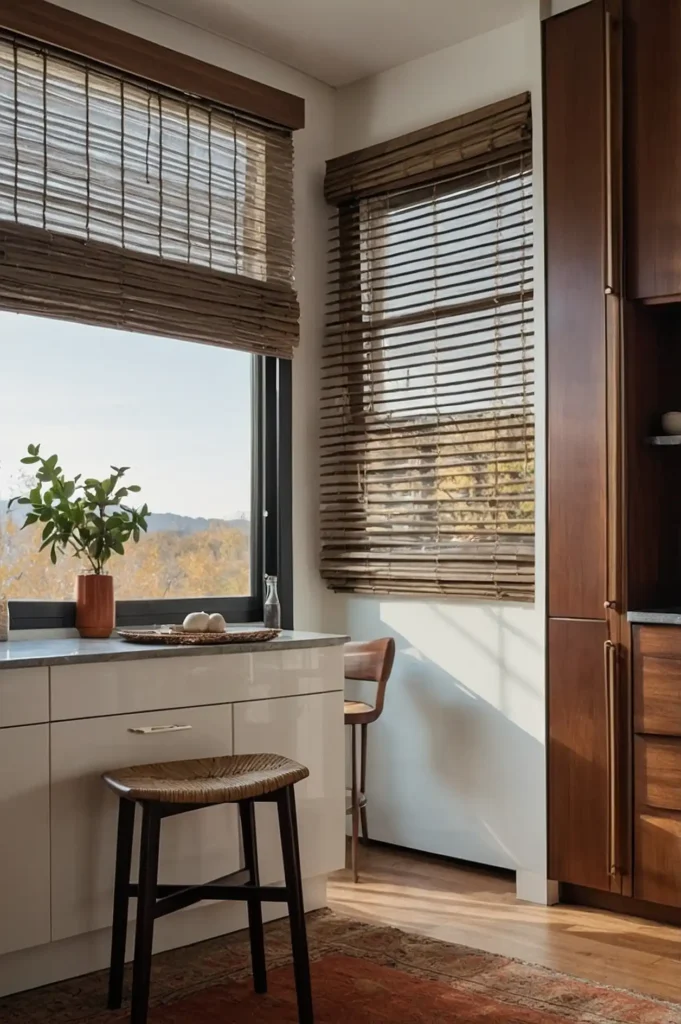
Select simple window treatments that don’t compete with architectural elements. Clean lines and natural materials maintain the uncluttered aesthetic.
Your windows become framed views rather than decorated openings. The minimal treatments preserve natural light while providing necessary privacy options.
Avoid fussy curtains or ornate blinds that conflict with clean design principles.
26: Functional Art Display
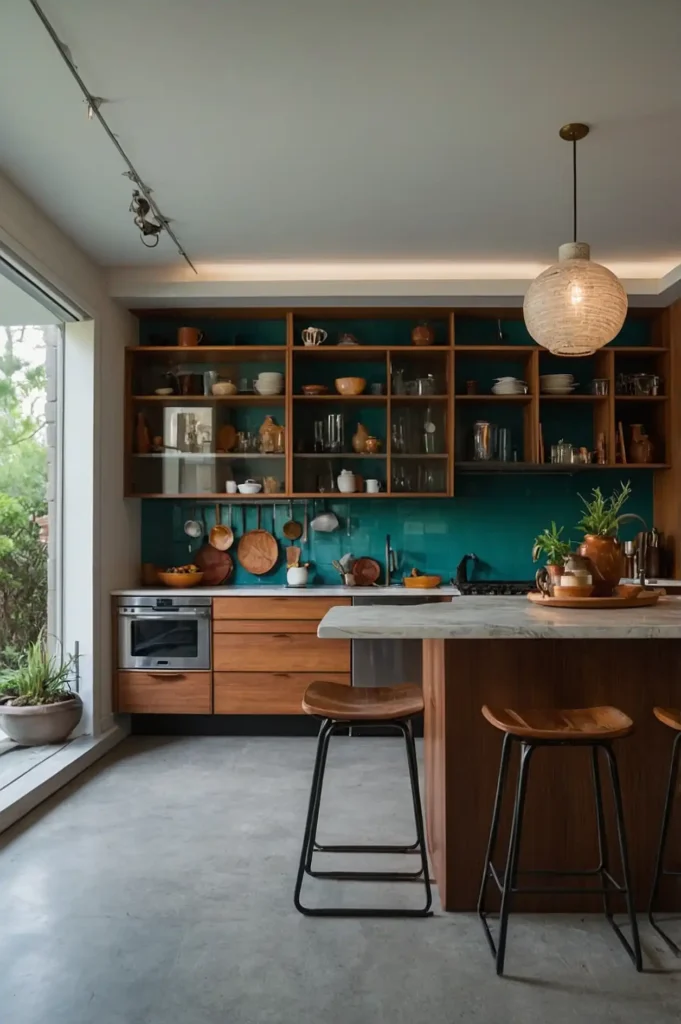
Incorporate functional art pieces like sculptural fruit bowls or ceramic serving pieces.
These objects serve daily needs while adding artistic elements.
Your kitchen becomes a gallery for beautiful, useful objects.
The functional art reinforces the era’s belief that everyday items should be beautiful.
Choose pieces that complement your color palette while serving practical purposes.
27: Technology Integration Planning
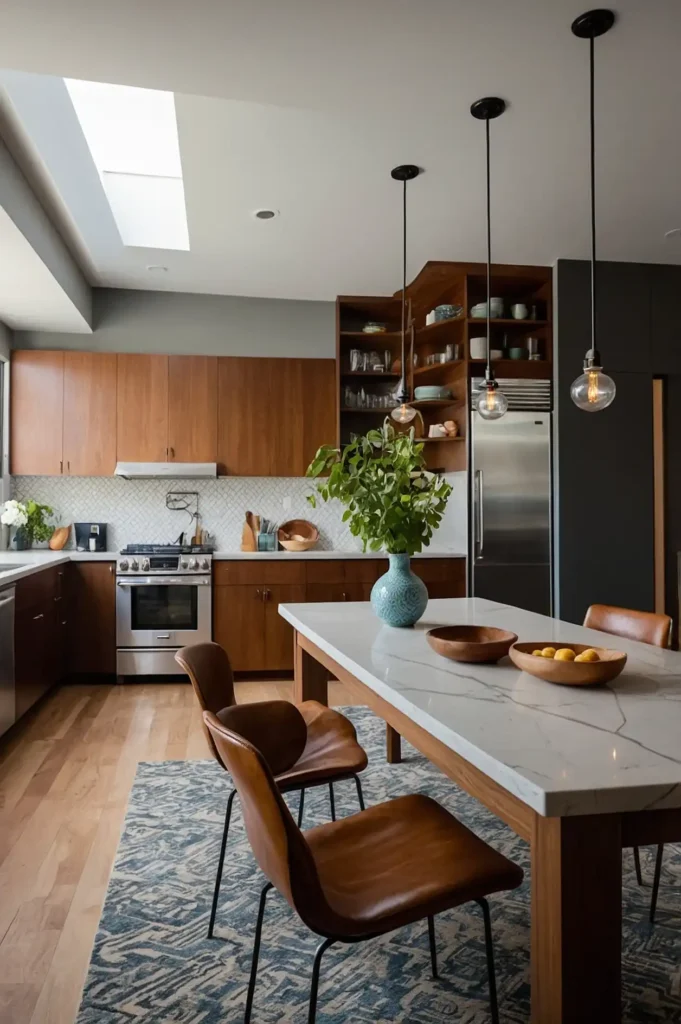
Plan for modern technology integration that doesn’t compromise period aesthetics.
Hidden outlets and discrete mounting maintain clean visual lines.
Your kitchen accommodates contemporary needs while preserving authentic mid-century character.
The technology enhances function without destroying design integrity.
Include adequate electrical planning for modern appliances and device charging needs.
Conclusion
These 27 mid-century modern ideas create authentic kitchens that blend retro charm with contemporary function.
Embrace clean lines, natural materials, and thoughtful design.

